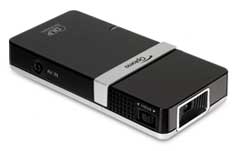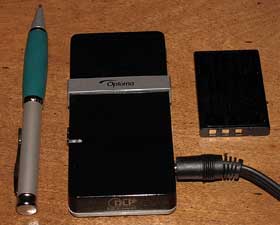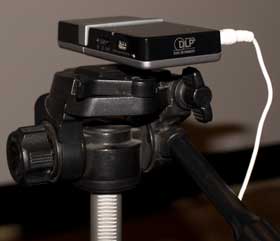I think it necessary to briefly discuss the abilites, the role and the types of usage these new projectors are best suited for, before focusing on this particular LED projector. Here goes:
The biggest question out there is who will buy them, and what will they use them for. It's been argued by some, that they can be used for presentations. Whether they are viable for presenting in the tradtional sense is iffy at best. I've been in the projector industry for more than 15 years, and even the early portables back in 1994, (about 20 pounds) produced 100 lumens or more, and here we have something only 1/10th as bright as the dimmest of those early projectors.
About three years ago we saw the first small LED projectors. Mitsubishi's probably being the best selling. Those types of LED projectors are much larger, and typically weigh in at more than 1/2 pound, excluding their battery packs which could bring them up to about 1 pound. That class of projector has proved abysmal in sales, considered a novelty by most, and despite typically 30 - 80 lumens, dim compared to the dimmest business projectors. Those larger LED projectors have found some specialty vertical markets, but their overall sales numbers are insignificant, compared to either business or home theater projectors.
Projectors like the Optoma Pico, however will find a different market, and that one primarily consists of working in conjunction with portable devices like cell phones, portable game machines (think Sony PSP3000, etc.) and a variety of other portable devices.
Ultimately industry forecasters see this as a huge market - bigger by far than the traditional projector market. One industry analyst projects (no pun intended) that as many as 15 million will be sold by 2012! There are, however two different types - first there are the stand alone projectors like the Pico, as well as competing models from 3M, AIPTEK, Samsung, and others. The rest of the sales are for the projector engine, to be built into other devices (like cell phones). The market for the engines to go into other devices is almost certainly the far, far, far, far (get the idea?) greater market. Imagine - if Apple decided to build a mini-projector into a future version of the iPhone (very likely), right off the bat, the sales of those LED projector engines (in units) would dwarf the unit numbers for traditional larger projectors (about 1.25 million projectors, worldwide in 2008).
So, what can we do with the Optoma Pico? I've had it hooked up to and working with my Wii, and my PS3, Oppo DVD player, as well as my iPhone, and an old portable DVD player system (with built in 7" diagonal screen and speakers). Right off the bat, I only see one possible reason for people to buy it with the larger game machines, and that's if they want to take their machine with them on a trip. The Pico then allows them to project the image onto a small screen, or small area of wall, but that's better than not taking the game machine for those folks.





